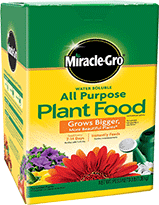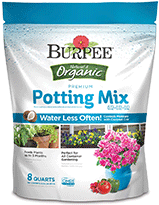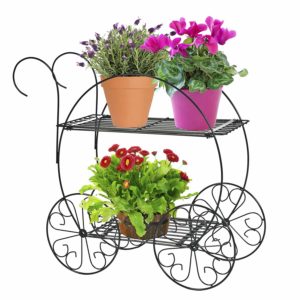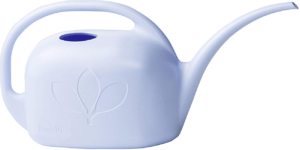A. Indoor Herb Gardens vs Outdoor Herb Gardens: Which is Right for You?
The nice thing about growing your own herbs is that you can grow them pretty much anywhere, indoors or outdoors. They take up very little space, they need minimal care, and even the smallest harvest from the plants can be very rewarding.
But should you grow your herb plants indoors or outdoors? Does it matter? The truth is, it’s totally up to you. Some gardeners and cooks like having plants both indoors and outdoors to ensure year-round harvesting and to always have fresh herbs to add to dishes in the kitchen.
Herbs Don’t Take Up Much Space Either Way
If you’re limited on space, that’s okay, you don’t need much. You can grow several varieties in just a single planter if you wanted to. That works both indoors and outdoors. Apartment balconies, tiny patios, and kitchen windowsills are all fine and dandy if you don’t have a big patch of raised garden bed to add your herbs around.
If you opt to grow indoors there is no shortage of fun garden kits and decorative window sill pots that you can choose from, including countertop hydroponic kits that help you grow fresh herbs quickly and effectively with very little care. If you decide to go outdoors with your planting, you can use up the outer edges of raised bed vegetable gardens, go for containers, or get creative and use things like wagon wheels and old tires for your herb garden.
I have a tiny kitchen inside, but I live in an area where it’s warm year round and we don’t get a hard frost, so I opted to put mine outdoors on the patio in containers. That way if it does happen to get really cold once in a blue moon I can grab the pots and bring them inside for the night.
If Amount of Sun is an Issue, Some Herbs Grow Well in Partial Shade
Sometimes when you choose to grow your herb garden indoors you have to deal with finding the best spot to put them so they get enough sunlight throughout the day. It can also be an issue on apartment balconies or very small yards. No worries, even with minimal sunlight exposure you can still have fresh herbs grown at home.
A few shade tolerant herbs that you might want to try include:
ï basil,
ï chives,
ï mint,
ï rosemary,
ï lemongrass,
ï and parsley.
Even with Almost No Natural Light, Hope is Not Lost!
If you decide to grow indoors and are still having a difficult time getting the right amount of sunlight through your windows, you can always try a planter with artificial sunlight attached to it. They’re a little expensive, but the rewards of owning one can be delicious in the kitchen. There are several varieties and sizes to choose from (small for two or three herb plants, medium for lettuces and herbs, and big for cherry tomatoes and other small vegetables) so it makes sense to shop around a bit and find the best planter for your situation.
Ultimately, it comes down to preference. Herbs can be grown both indoors and outdoors, so weigh your options and go for the place that has the best sun, the most space, or just go all in and have planters both indoors and outdoors.
B. Tools of the Trade for Herb Gardeners
One of the nicest things about herb gardening is that you don’t really need a lot of tools and supplies, just a few basics. It’s perfect for beginner gardeners or for those who have minimal space available for storage. Aside from your plants and containers, there are just a few things you’ll want to have on hand.
Sharp Pruning Snips Make Life Easier
If you only buy one thing on this adventure, I recommend it be a nice sharp pair of pruning snips. It makes life so much easier and using scissors instead of pulling or plucking insures that you don’t do damage to the overall plant.
These don’t have to be anything fancy and you can use your kitchen scissors if you really
want to. Whatever you decide to use, just make sure the blades are sharp for a nice clean cut.
Fiskars makes an easy to squeeze pruning snip that’s perfect for herbs and rarely need any sharpening, they’re my go-to product choice. (http://www.amazon.com/Fiskars-9921-Softouch-Micro-Tip-Pruning/dp/B00004SD76/)
Quick tip: You can also use these snips to cut up your fresh herbs while you’re cooking if you’re not comfortable using a kitchen knife to chop them. Perfect for letting kids help, too.
Soils and Fertilizers
Potting mix is generally recommended for growing herbs at home. There are lots of choices available both online and in-person at your local home and garden center or nursery. Grab something packed with organic materials and youíre all set.
When it comes to fertilizing your plants, indoors and outdoors, a natural compost tea is a great alternative to expensive off the shelf products. If you donít have a compost bin and want to pick up a prepackaged bag or a bottle of liquid fertilizer, just be sure to read the package and ingredients carefully. Anything you use on your herb plants needs to be safe for edibles and generated from organic materials.

|

|

|
Small Watering Can
Remember that dripping wet plant leaves can lead to mildew growth and disease problems,
so you want to water at the soil or ground level so the water can soak down and absorb into the roots. A small watering can makes this a little bit easier when it comes to small plants, even if your plants are outside.
Herb Keepers for Storage in the Kitchen After Harvest
You want to prune and harvest regularly so that your plants continue to grow and provide fresh herbs to use, but you need to store those someplace. There are lots of options for storage and weíll discuss some of those in more depth later on.
Aside from your standard storage methods, some of the latest innovations in kitchen technology have brought us some fun storage keepers, containers, and pods that are easy to use and designed especially for the storage of herbs ñ and they look kind of futuristic and fun too.
There are plenty of other things you could buy if you wanted to really go all out, but you really donít need a lot of fuss or expensive gadgets to be able to enjoy growing your own herb garden. Start with one or two things and add to your collection of tools over time.
C. 5 Common Herb Gardening Mistakes and What You Should Do Instead
While herb gardens are a little easier and more relaxed than other gardening types, there are still some things youíll want to stay on top when tending to the plants. If you avoid these common herb gardening mistakes youíll have longer plant life, more harvested herbs for your kitchen and medicine cabinet, and of course with less problems youíll enjoy the whole activity much more.
Don’t Plant Everything So Close Together and DO Space Things Out
This is probably the most common mistake when it comes to planting a variety of herbs, especially outdoors where cute layouts and fun planters are used (think wagon wheels and tires, etcetera.) Everyoneís first instinct is to ìcoverî as much of the ground and mulch as possible and just have the pretty parts of the plants showing up top, maybe with a few more colorful flowers in between.
The good news is that this is the easiest problem to fix, even if youíve already planted. You want to space things out appropriately, just like you would if you were planting tomatoes and other vegetables, so thereís plenty of room to form a healthy root system without getting tangled into the neighboring plantís roots.
When transplanting make sure you check out the information on the average size of the fully grown plant and allow several extra inches for those root systems to grow and spread.
? Healthy roots = healthy plants and yummy harvests.
? Crowded roots = sad withering plants that donít produce delicious things.
Don’t Use Designer Dyed Mulch for Looks and DO Go Organic and Natural
If you lay mulch on top after planting, avoid the heavily dyed ìcoloredî mulch and go for natural mulch instead, preferably something that is 100% organic material.
The dyed mulches might look pretty, but theyíre generally made of junk and scrap wood, dyed with artificial colors to be red, green, or black, and the result of all that is that they donít break down well, and they definitely donít help your soil quality at all. In fact, they often rob your soil of the natural nitrogen your plants need to grow vibrant and strong.
If youíre growing your herbs indoors, you may want to skip the layer of mulch entirely and just go for a good organically enriched potting soil.
Don’t Use Chemicals and DO Use Natural Fertilizers and Bug Repellents
There are so many products available to gardeners, all promising to keep bugs away or to make your plants grow fuller and larger. Unfortunately, a lot of these are full of harsh chemicals that you donít want to use when youíre growing anything you intend to put in your mouth at some point.
If itís in a package, a box, or a spray bottle, check the ingredients before you put it anywhere near youíre herb garden. If you wouldnít want it stored under your kitchen sink, you donít want it in your soil either. Sometimes these chemicals get picked up unknowingly when shopping the garden department, not realizing the fertilizer theyíre putting on the cart is full of additional chemicals.
If itís fertilizer youíre looking for, try a natural compost tea instead of a prepackaged solution. If youíre in a rush and want to grab a bag, just be sure to flip it over and read the back carefully. It needs to be safe for edibles and generated from organic materials.
When it comes to insect control, it might not be as necessary as you think and itís very possible you could go an entire season without having to do anything about pests, especially if the area of your garden is all herbs or if youíre using containers.
Water and weed regularly, keep debris out of the soil area, and just keep an eye on things. Remember, not all insects are bad news, some are very beneficial. If a persistent pest problems comes up that is in fact a problem, there are natural and organic solutions available that are usually more effective than their chemical based counterparts.
Don’t Water the Leaves and DO Water the Soil
Watering over top of the leaves doesnít do your herb plants (or any plants) very much good. Water gently at the soil around the base of the plant and let the water absorb. Dripping wet upper leaves can lead to mildew growth and disease problems.
Don’t Ignore Your Herb Plants and DO Prune and Harvest Regularly
Cutting the leaves and stems will keep your plant in grow mode, producing even more delicious leaves and stems. If you let it go without pruning for too long it might finish out its growth cycle and you wonít get much of anything to harvest after that. Keeping things pruned back on a regular schedule will promote a nice healthy growth and keep your kitchen full of the freshest herbs possible.
At the end of the day, herb gardens donít need all that much tending to. Youíll want to keep an eye out for problems, but herbs are generally hardy, resilient, and easy to grow ñ both indoors and outdoors. A little bit of water, a sparkle of sunshine, and little bit of attention from you and everything will most likely grow just fine.
D. 3 Reasons to Include Lavender in Your Home Herb Garden
Lavender is often overlooked when it comes time to do the planting and management of your home herb garden. Itís relatively easy to grow and has lots of uses around the house, aside from just looking pretty and smelling nice, though it definitely does those things well.
Natural Disinfectant, Antiseptic, and Even a Bug Repellant
The lavender plant is already well known for its calming and soothing use as an aroma therapy, in lotions and bath products, etcetera, but the essential oil mixed with a bit of water can also be used as a natural disinfectant on surfaces and even on your hands.
If thatís not enough, crushing the plants and rubbing the oils on your arms and legs can serve as a fly and mosquito repellent while youíre outside working in the rest of the garden. It can also be used to soothe bug bites, stings, and the occasional scrape. The oils blended into a good lotion can help soothe a sunburn too.
Delicious Drinks and Foods
The fragrant and flowering plant is not often thought of as edible, but it certainly is and it makes a great addition to recipes, especially baked goods. You can add a bit to cakes and frostings for a special occasion treat that tastes like it came from the expensive bakery in town.
It also makes a wonderful calming hot tea that can help you relax for bedtime. A sprinkle of lavender in lemonade or while brewing iced tea is also quite refreshing and soothing on hot days.
If youíre feeling especially adventurous, it can even be used in salad dressings, syrups, sauces, and fresh made jams or jellies. My favorite is a little bit added to the blackberry jam on canning day ñ spread a bit of that on your toast in the morning, itís simply amazing.
Around the House with Fragrances, Gifts, and Pretty Things
It wouldnít do to leave out all the things that smell nice and look pretty when it comes to using fresh lavender from the garden. The freshly picked blooms from your herb garden will far outperform anything you buy at the store.
If you need a quick gift on the fly for a hostess or for a friend, you can make a lavender wreath, put together a scented sachet, a bit of potpourri, sew a custom eye mask, or just cut off a transplant and put it into a pretty pot or mason jar to give them their own plant to grow.
Around the house you can freshen the carpets with dried plants, make a room spray with the essential oils, and decorate with fresh blooms in vases alongside a few other wild flowers or all on their own.
If youíre just looking to relax, a lavender bath is great for your skin. The great thing here is you can experiment with different forms of the plant in the bath ñ you can add fresh or dried sprigs to the hot water, or you can use the essential oil and some Epsom salts. No matter how you use it here, itís sure to be relaxing and rejuvenating.
Now that weíve gone over a few of the reasons you might want to plant some lavender in your home herb garden, itís time to go out and play in the dirt and make a little space for a few plants. Youíll be glad you did.
E. Storing Your Fresh Cut Herbs
You want to prune and harvest regularly so that your plants continue to grow and provide fresh herbs to use, but you need to store those someplace. You have a few choices available and what you decide may depend on which herb youíre storing and how long you want it to last.
Storage in the fridge:
Fold a paper towel and put it inside a zipper bag, place your fresh herbs on top of the paper towel, gently press and close. Store in a bin where you can adjust the humidity and temperature levels. This works especially well for rosemary and thyme, but Iíve also stored fresh chives this way.
A lot of fresh cut herbs will rot and go bad very quickly when you put them in the fridge, so sometimes itís better to skip the refrigeration and go for countertop or freezer storage.
Storage on the countertop:
Just like fresh picked flowers, you can store your herbs right on the counter in a little bit of water and a glass container. Just snip the ends and add about an inch of water before placing the stems in. This works especially well for basil, cilantro, and parsley. (Basil especially, as it tends to turn black very quickly if you pop it in the fridge.)
There are also plenty of fancy herb keepers available online and in stores these days. Youíll find pods, specialty bags, and a variety of snap shut containers all designed to keep your herbs their absolute freshest all the time.
Storage in the freezer:
Sometimes you just have too much to use right away and youíre not sure youíll be able to use it up before it goes bad. I found this cool trick on Pinterest one day and was pleasantly surprised when it turned out well.
Chop your fresh herbs as you normally would and divide into ice cube trays, pour your favorite olive oil over top, and pop into the freezer. Once theyíre frozen solid you can pop them out and sort into individual freezer bags for long term storage. Just make sure you label them all before you walk away Ö once theyíre frozen in the olive oil they all start to look similar and it can be difficult to distinguish which are which. Grab one when youíre cooking and youíre ready to go. Theyíre perfect for soups, stews, and sauces.
Drying the herbs for storage:
Dried herbs from your garden will still out-flavor most store bought brands and off-the-shelf herbs. As an added bonus, when you do this yourself at home, youíll know without doubt that there were no unwanted preservatives added to them in the process. (and of course your house is going to smell wonderful during the process too.)
Thereís a nice tutorial on how to do this available at About.com. (http://gardening.about.com/od/vegetablepatch/a/DryingHerbs.htm)
Enjoy!
Donít forget to actually enjoy the herbs you grew and saved! They so often get shoved into a pantry or drift to the back of the refrigerator without being used. Experiment with them, add flavor to dishes you cook at home, and enjoy every single bite.



